中 華民國空軍 / Chung-Hua Kong Min Guo Kong
Republic of China Air Force / Taiwan
Last update 09-11-23
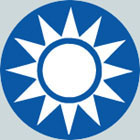
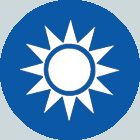
 Credit: Roundels of the world
Credit: Roundels of the worldRoundel till 1991 Roundel from 1991 Low visibility roundel from 1991
NORTHROP F-5A / NORTHROP F-5B
In
1963 the Republic of China (Taiwan) placed an order for 60 F-5A Freedom
fighters, though it was originally envisaged to buy 115 aircrafts;
delivery began in 1965 and was completed in 1968. These aircrafts
were foreseen to replace F-86F, widely used in the battles against
People's Republic of China Air Force Mikoyan-Gurevitch MiG-15s and
MiG-17s in air-battles over the Taiwan Straits during the year 1958.
The
first Northrop F-5A and F-5B equipped Squadron was officially accepted
by the AIr Force Commander on 09-12-65 at Tainan AB. The unit was at
the time still in training status by Jamuary 1966 with
7 Northrop F-5A and 2 Northrop F-5B of the 19 F-5As and 2 F-5B foreseen.
Later deliveries enabled to equip the three Squadrons of the 1st Wing at
Tainan AB. An USAF Mobile Training Team supervised the introduction of
the Freedom Fighters.
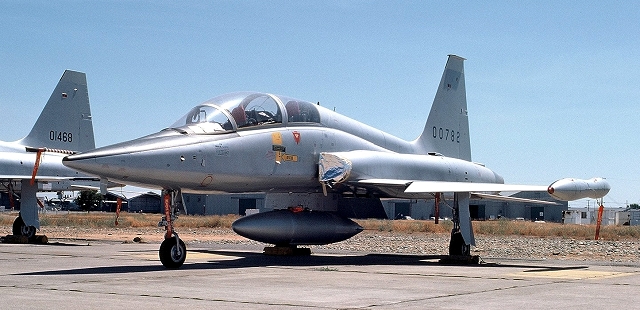
Northrop F-5B 00782 at
McClellan
AFB before delivery in July 1975
Photo: D J Fisher
This is one of 10 additional 1974
Fiscal Year F-5B bought directly by the Republic of China.
 Photo: RoChina AF
Photo: RoChina AF
The first Northrop F-5A Frredom Fighter delivered, no unit painting. In
front local pilots with US instructors
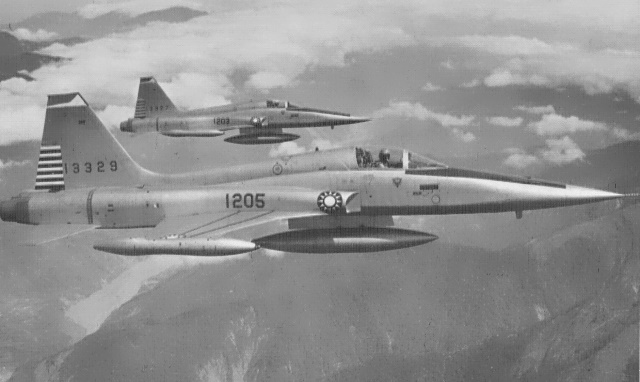 Photo: RoChina AF
Photo: RoChina AF
Early air-to-air picture (without Squadron colours) Of Northrop F-5A 1205/13328 and 1203/13327
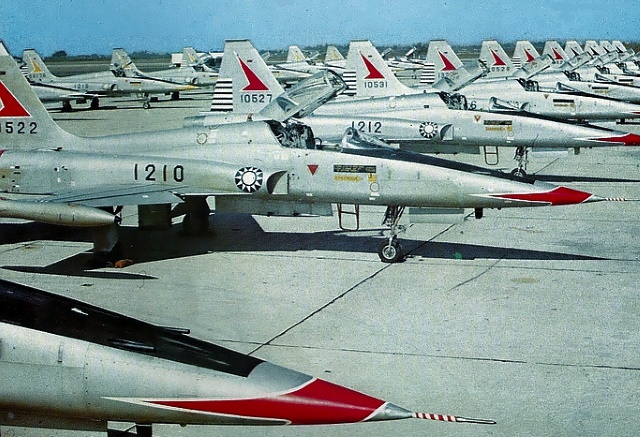
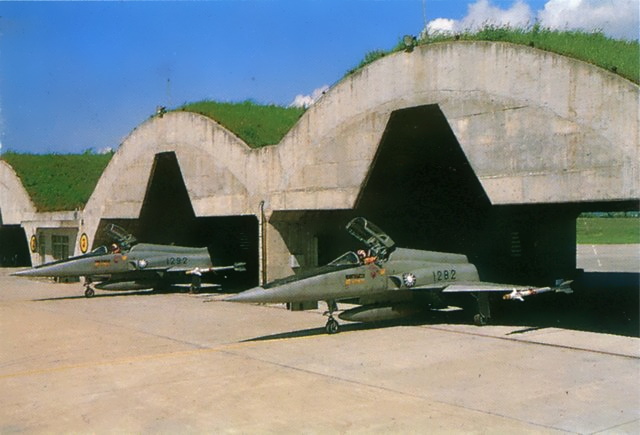
Line-up of Northrop F-5As belonging to all three Squadrons attached to the 1st Wing. Photos: RoChina AF Sidewinder armed Northrop F-5As (late colours) in alarm shelters
Under pressure from the USA government 48 Northrop F-5As and spare parts were put at disposal by 10-11-72 for the transfer to the Republic of Vietnam Air Force under Chinese program "Huiguang Exercise",
the USA "Enhance" and "Enhance Plus" programs; originally the USA requested the transfer of all (94) F-5As received by the Republic of China; this was not accepted by the Republic of China government. As a
compromise, it was agreed to station two Squadrons of USAF McDonnel F-4C at Ching Chuan Kang AB to fill the gap till the return of the F-5As, to supply 28 Northrop T-38As to keep pilots proficent and to
examine the possibility of a Northrop F-5E co-production scheme.
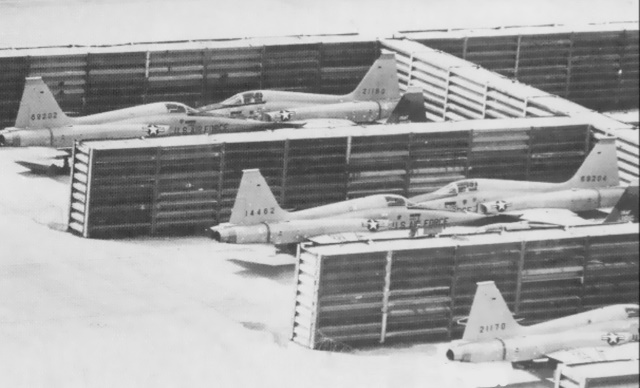 Photo: unknown
Photo: unknownFive former Chinsese AF (serials 21170, 14462, 69204, 69202 and 21160) still in metallic colour and with USAF
markings on delivery to South Vietnam at Bien Hoa AFB. The tail of camouflaged one can be seen farthest.
Twenty Northrop F-5A were to be returned
directly from South Vietnam,
28 additional eventually replaced by Northrop F-5Es; the first USAF
F-4C Squadron was to return to USA upon arrival of the first 20,
the
second F-4C Squadron and the T-38As when the remaining 28 F-5As would
be replaced. In addition, 15 new Northrop F-5B were to be directly
purchased in USA under the code name Peace Ox.
Finally it was agreed to
co-produce,
mainly under Foreign Military Funds,
100 Northrop F-5Es in the Republic of China.
According to official US
Military Assistance
Program files, Taiwan
has received by 1970 72 Northrop F-5A and 11 F-5B under MAP, supplied
as follows: 1964: 7 F-5A, 2 F-5B; 1965: 10 F-5A; 1966 26 F-5A, 4 F-5B;
1967:
22
F-5A, 5 F-5B; 1968: 5
F-5A; 1970 2 F-5A.
The exact number of Freedom
Fighters supplied to the Republic of China
AF is not known. Twenty two Fiscal Year 1969 F-5As and 10 Fiscal Year
1974 F-5Bs are missing from the list; they might have
been paid in
full by the Republic of China,
not going through the Military Aid Program.
Known
Northrop F-5A serials are 1201 up to 1292 (giving a total or 92
aircrafts, possibly including former Republic of Vietnam aircrafts;
Northrop F-5B 22 or 23 aircrafts serials 1101 to 1122 (possibly 1123).
A source states that only 15 Northrop F-5B were on strength in 1975.
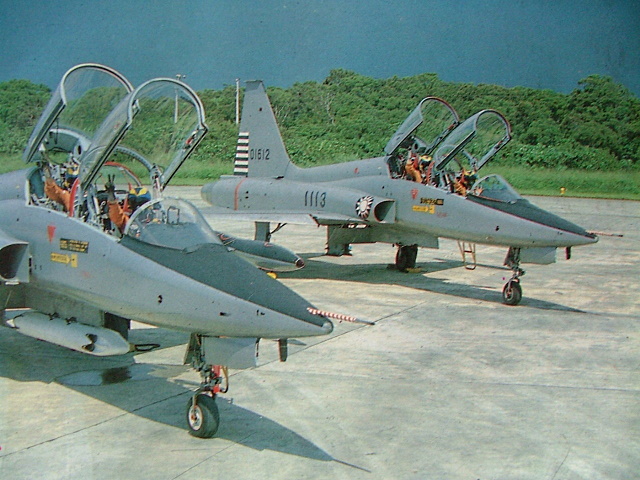 Photos: unknown
Photos: unknown 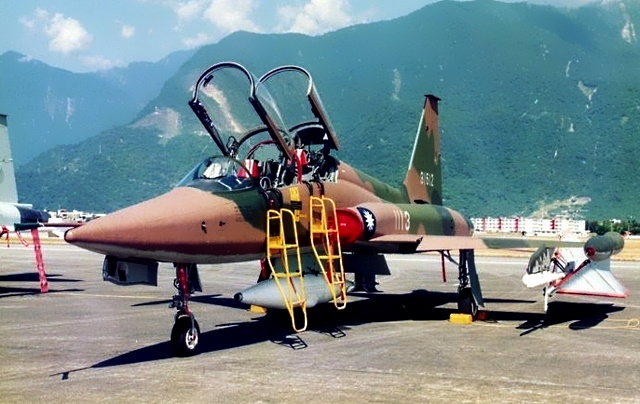
Northrop F-5B 1113/01612 next to rocket launcher equipped one, still in silver colours. Same Northrop F-5B 1113/01612 at the end of its carear used as Target Tug.
By mid 1973 47 Vietnamese F-5As were withdrawn from use for repairs and treatment of heavy corrosion and stored at Bien Hoa AFB. As they were in poor conditions, beyond Vietnamese technical capacity, they were
tranferred to of China - Ping Tung AB (under code name Project Peace Basket ) for rework, together with 17 General Electric J85-13; 20 of these Freedom Fighters were to remain in Taiwan to satisfy the first clause of
the USA/Republic of China agreement (return of 20 F-5A by July 31, 1974). The first two F-5A were delivered from Vietnam on November 7, 1973. By the end of April 1974, the first reconditioned F-5As were ready to
be painted.
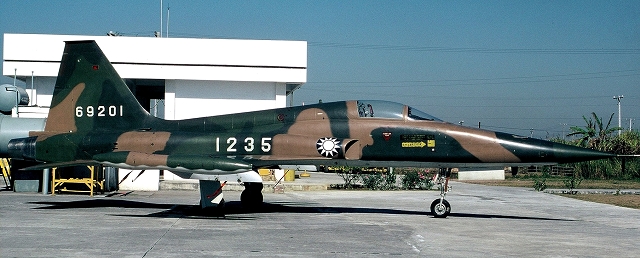
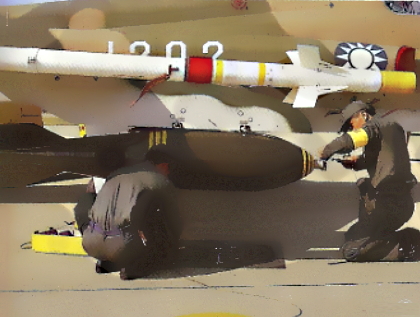
In the meantime the Republic of China had requested the supply of McDonnel F-4 or additional Northrop F-5E instead of the worn-out 20 Northrop F-5A, but this requested was rejected by the US government.
The second clause of the agreement, the withdrawal of one USAF Squadron of McDonnell F-4C to Clark AFB (Philippines), was completed by the end of July 1974.
Remaining F-5As and F-5Bs Freedom Fighters were relegated by the mid-70s to the training role with the 828th Tactical Fighter Wing at Hualien AB, replacing North American F-86Fs, until withdrawn
from use on 30-06-87, the last F-5Bs remained longer in service, till mid '90s (local serials 1112, 1113, 1116, 1121).
Retirement ceremony for the last Northrop F-5A was held on 30-06-76; ceremony for the Northrop F-5B followed on 30-06-85 by serials 1112/1116 in a mixed formation with one Northrp T-38 and one Northrop F-5E.
Some single- and two-seaters Freedom Fighters were preserved at bases and museums after withdrawal, three F-5As were supplied in 1993 to the Philippine AF, one in exchange of a North American F-51D for a
museum.
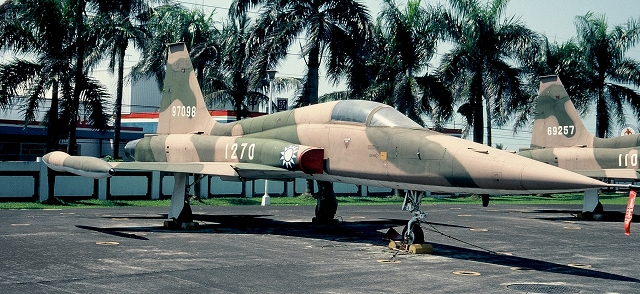
Northrop F-5A 1270 97098 preserved in the latest camouflage at the AF Academy Kangshan 18-08-00
In the background F-5B 1104 69237 erronously marked as 69257
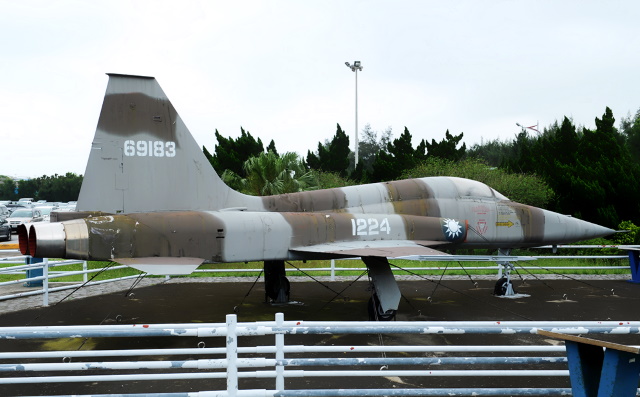 Photo: Toshi Aoki/jp.spotters.com
Photo: Toshi Aoki/jp.spotters.comPhantasy camouflaged Northrop F-5A, erronous font US serial on tail, at Taoyuan on 03-06-12
NORTHROP F-5E / NORTHROP F-5F
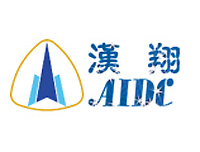
A Memorandum of Understanding, signed in on 09-02-73 with the government of the United States, granted fulfilment of another clause: providing 28 Northrop F-5E, aircraft locally named
"Chung Cheng", the nickname for the late President Chang Kai Shek, as replacement of the second batch of 20 Northrop F-5A by the end of May 1975. The IAI Kfir C2 had been earlier
taken also in consideration, up only to the technical evaluation phase.
The Memorandum foresaw establishment, under the codename "Hu An" (Peace Tiger), of co-production facilities in Taiwan for approximately 100 F-5E/F. The initial phase was final assembly
and flight test at the Aero Industry Development Center at Taichung (AIDC), followed by an increasing amount of assembly and production of elements as soon as know-how and facilities
were available;
General Electric J-85-GE21 engines were to be supplied directly by the USAF. A later request for licensed production of these engines was turned down.
Delivery of US built airfames
was on board of Lochkeed C-5A Galaxy in 8-pack, starting in August
1975. Roll-out of the first
locally assembled aircraft
took place on 30-10-74, the last of
the initial 100 airframes being
completed in November 1977.
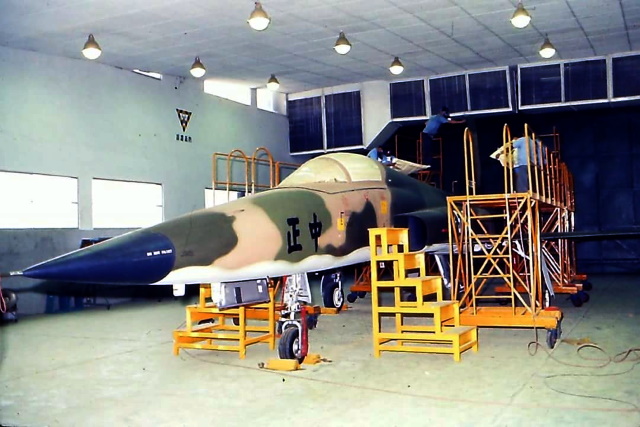 First AIDC Northrop F-5E assebled by AIDC
First AIDC Northrop F-5E assebled by AIDC


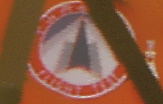
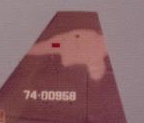
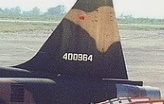
Tiger Team badge on
pilots' US FY serial only on
5101/02
Shortened FY serial (6 numbers),
suite
confirmed by photo
confirmed by photo,
on serial 5107.
On
01-12-74 a task force called "Sung Shan" (Tiger Team) was established at Tainan to
prepare conversion of the Wing to the new aircraft model. First unit to
receive the second generation Northrop F-5
aircraft was
the 443rd (1st) Tactical Fighter Wing at Tainan in December
1974 enabling the withdrawal to Kadena (Japan) of the second USAF Mc
Donnel F-4 Squadron by April 1975. By mid-April of this year AIDC had delivered
33
F-5Es, increasing production output to 4 per month.
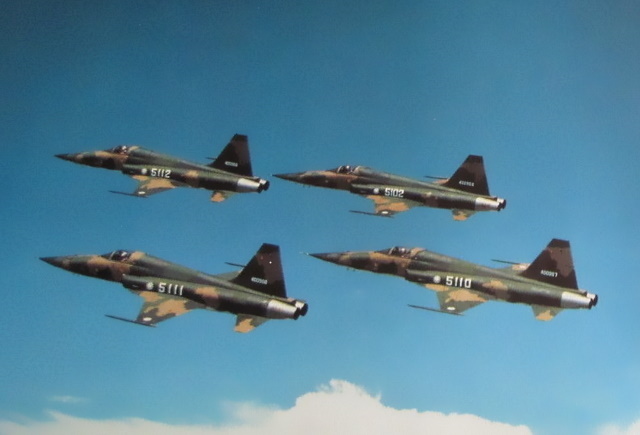
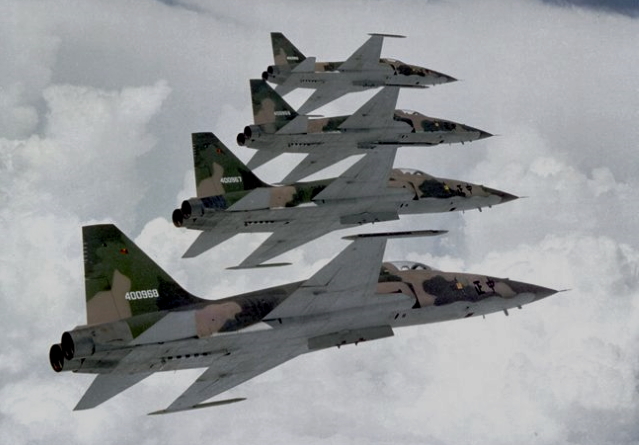 Photo: Northrop
Photo: Northrop
Early delivered Northrop F-5E with SEA camouflage, also showing early
six numbers tail
serial
In-flight view, initial camouflage/US tail serials Northrop F-5Es
presentation, unfortunately not readable on the photo. Photo: R of China AF
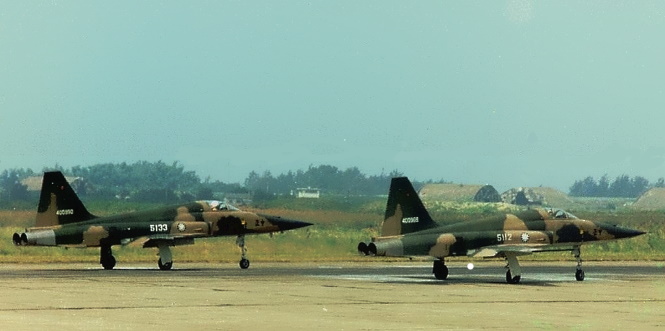
First batch, camouflaged Northrop F-5E 5112/400969 and 5133/400990 on take-off.
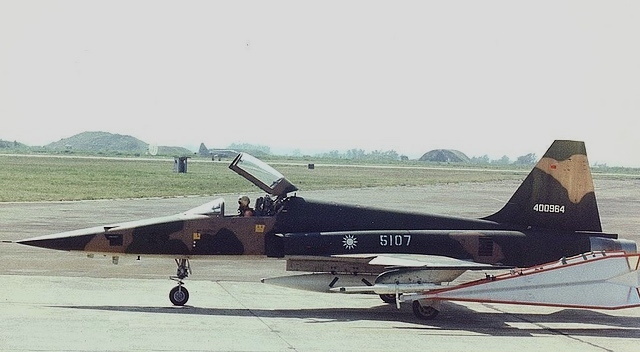
An early Northrop F-5E, serial
5107, in use as Target Tug
The Republic of China requested in April 1976 an Letter of Offer to co-produce an second batch of 42 additional Northrop F-5E and 18 F-5F with an option to extend local production with an additional 20 single-
/two-seaters, if finance permitted. This was granted; 2 more single-seaters were built, for a total of 44. First Northrop F-5F was delivered 01-11-78.
Repeated requests for Mach 2 fighters, Mc Donnel F-4s, Lockheed-Martin F-16As, F-16/79s or Mc Donnel F-18s, were constantly refused by the US governement. Even an attempt to buy the latest generation F-5
(Northrop's F-20) was blocked by President Carter's veto in October 1978. The year 1978 saw also the offer by the People's Republic of China of a reward of USD 1.8 million for an F-5A, 2.1 million for a Tiger
defecting to the continent.
Formal diplomatic relationship with the People's Republic of Chinas was established by the USA on Jabuary 1st, 1979 recognising this as the only governement for the whole of China - including Taiwan. This
recognition had dramatic consequences for the Republic of China (Taiwan) and its Air Force.
Military aid was suspended but outstanding orders could be fulfilled, inclusive co-production of the Northrop F-5E/F, ordes totalling at the time 185 single- and 21 double-seaters.
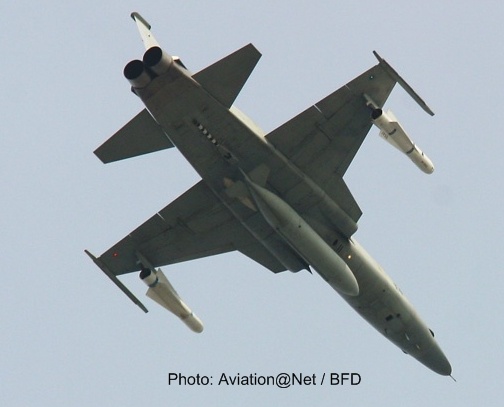
On July 1979 approval was also given by the US Congress for the sale of 39 single- and 6 two-seater F-5s, wired for Hughes AIGM-58A
Maverick precision guided missiles, costing USD 108.8 millions; 29 laser target designator sets and 48 modification kits for the aircrafts
(USD 61.8 m), 500 Mavericks and 100 single rail launchers (USD 25 m) were part of the deal on offer at the end of 1978.
A total of 308 aircrafts were produced by AIDC under 6 Peace Tiger programs:
Peace Tiger 1 included 100 F-5E; Peace Tiger 2 44 F-5E; Peace Tiger 3 20 F-5E, 3 F-5F; Peace Tiger 4 15 F-5E, 15 F-5F; Peace Tiger 5 30 F-5E, 18 F-5F; Peace Tiger 6 30 F-5E and 30 F-5F; the last of these was
rolled out on 09-12-86. Global total was for 242 single- and 66 double-seaters
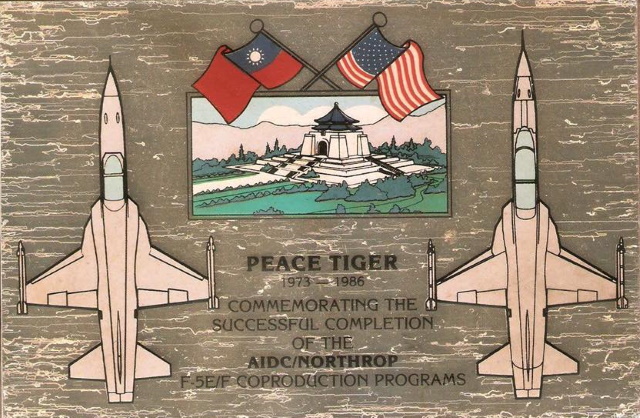 Photo: AIDC/Mike Lee
Photo: AIDC/Mike Lee OPERATIONS / TRAINING
Little is known about early use of the Northrop F-5A. Air-superiority above the Taiwanese skies was assured by Lockheed F-104s Starfighters in the various versions from 1960; Freedom Fighter were in charge
for air-to-ground support and, as secondary duty, for air-combat; no encounters by Freedom fighters with People's Republic of China fighters are known. Single-seaters were stationed in March 1972 at Makung
(island in front of the People's Democratic Republic of China).
Northrop F-5Bs participated, together with Fairchild C-119s, Lockheed T-33As, North American F-100s and Lockheed F-104s to trials for emergency use of highways on 19th and 20th October 1978.
Tiger armed units had ground-attack as main duty as well as air-interception duties. Ground-attack was performed against land and sea targets with Mk.82 500 lbs freefall bombs, 7.15 in (19cm) unguided rockets
and AIGM-65A guided missiles, 48 single-seaters incorporating a cathode-ray tube with scan converter which allowed the pilot to view the TV picture produced by the missile
Twenty nine of the F-5Fs have been fitted with the Northrop AVQ-27 manual laser target designator to provide an atonomous designation capability for the GBU-12 laser version of the Mk.82 bomb, training done
against land and sea targets with bombs, unguided rockets and guided missiles.
In the air-interception task all F-5 equipped Squadrons performed 4-5 combat patrols a day across the Strait of Taiwan armed with locally modified AIM-9J Sidewinders, flying close to the coast,in addition to escort
of transport aircrafts flying to Kinmen (Quemoy), the largest island of a cluster under ROC control. Fighters were ready for an 3-minutes scramble, one Squadron of the 4th TFW being based from April till October
on the forward base at Makung, on the Pescadores Islands.
Additionally, routine patrols over the Strait of Taiwan, up to a maximum of 15 miles to the Chinese mainland, encountered MiG-19s and MiG-21s flying parallel to the coast. Up to once or twice a week, PLAAF
aircrafts entered Republic of China airspace, retreating when F-5s appeared. No F-5E Tiger air-combat is known.
Soviet reconnaissance Tupolev Tu-95 Bear and Ilyushin IL-62 trasports, flying every year closer to Taiwan, escorted along the coast by Northrop F-5E of the 5th Group in formation flight. This ended with the
wound-up of the Soviet Union.
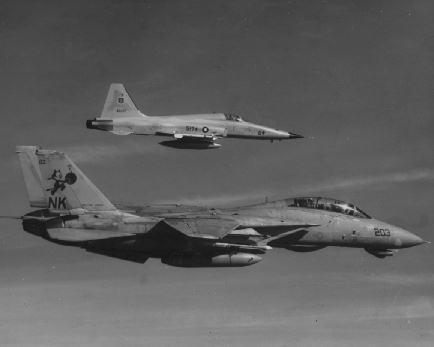
Meeting a friend. Aircrafts from transiting US Navy fleet were shadowed" by Republic of China aircrafts. Here an F-5E from 443th Wing, possibly serial 537, flying alongside an US Navy F-14 VF-31 probably in the
mid-90s.
An Tactical Training and Development Manoeuvering Instrumentation (TACTS/AMI) at Taitung/Zhihang AB, similat to the US Top Gun, was created in 1976 to keep pilots up to the highest fighting level . It was upgraded to
Tactical Aircrew Training System/Air Combat Manoeuvering Instrumentation (TACTS/ACMI) range on July 1st, 1988. In mid-90s, the ROC AF decided to upgrade again it, expanding the airspace, as the People's
Republic of China introduced avanced fighters such as the Sukhoi Su-27. Additional improvements took place in July 2002, when the installation of a Cubic Corporation system, based on the Nellis AFB Air Combat
Training System, was completed; this supported F-5, F-16, Mirage 2000 and IDF pilot training. The system was further improved with new weapons simulation devices by March 2004.
The range has been used by all fighter units, dissimilar training given initially by the 46th Tactical Fighter Squadron's F-5Es and F-5F, which gained a high ratio of scores against the latter generation fighters.
Simulated firings of AGM-65C/E Mavercks laser guided missiles from F-5Es have also taken place on the range during 2007 with full success. These missiles might be local updates of the original AGM-65A television
guided missiles.
DEFECTIONS
Defection from the People's Republic of China
An Boeing 747 from South Korea was escorted on 24-08-83 precausionally to Taiwan by 8 Northrop F-5E; a Chinese People's Republic Navy pilot who had defectd to S. Korea with its J-7II was onboard. Another 8
were on alert at Taoyuan AFB.
On 14-11-83 2 Northrop F-5E escorted an Chinese People's Republic Navy Shenyang J-5 whose pilot defected to Taoyuan AFB.
These aircrafts (and others) were tested against Republic of China fighters
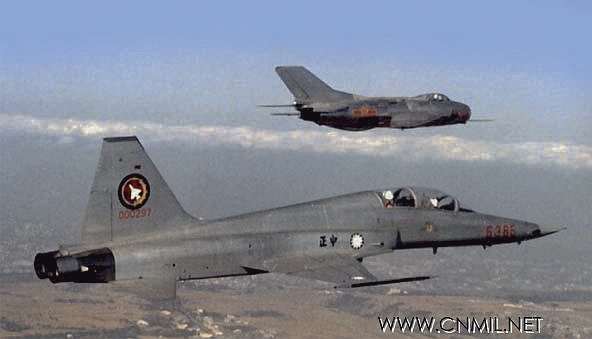
An 46th Squadron F-5F chasing an Chinese People's AF J-6 (MiG-19) while being tested by an R of China AF pilot.
Defection to the People's Republic of China
A new chapter in the Republic of China F-5 history was opened: defection towards mainland China. China's government promised 2 millions Dollars for the delivery of an Northrop F-5 to
mainland. Major Huang Zhi Cheng, an instructor pilot, defected on on August 8th, 1981 to the People's Republic of China with its Northrop F-5F serial 5361; the aircraft landed at an
air-base near Fouchou City (Fukien region) The defector obtained a reward of USD 370'000 (sum immediatey returned) and was nominated
Deputy Commander of a pilot training school. The aircraft has been most probably tested locally and remained in the People's Republic of China.
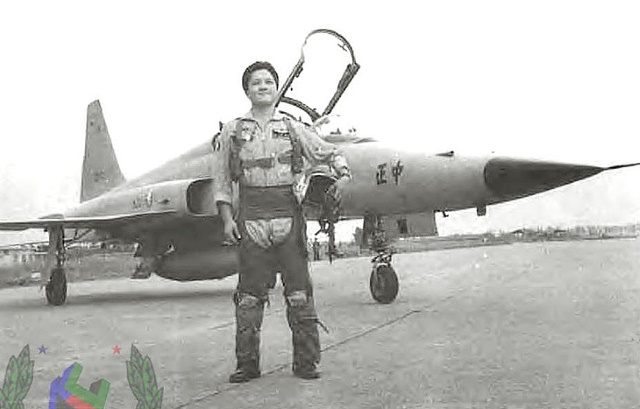
The defecting pilot next to its Northrop F-5F, serial 5361
A second RoC AF F-5 Tiger defection happened on 11-02-89, when the pilot of Northrop F-5E serial 5120 ejected 80 km inside the Guangdong province, the pilotless aircraft being destroyed and the remains put
on show at the Chinese People's Revolution Museum at Xiaotangshan (Datangshan).
OPERATION ABROAD -Yemen
The Republic of China AF has no possibilities to participate to excercises abroad due to the diplomatic isolation of the country, but another form of sevice abroad, never officially confirmed, has been rumoured.
This was the only air combat operation of the Air Force and involved rervist, service pilots and technicians being engaged in a country unable, for various reasons, to operate its Northrop F-5s.
Following skirmishes between North and South Yemen in March 1979 the US governement rushed into Northern Yemen 12 Northrop F-5Es and Saudi Arabia 2 Northrop F-5Bs to boost its air defence..
Taiwan media reported that some (sources state 12) Taiwan pilots plus ground technicians (mainly reservists) arrived in North Yemen as counsellors/pilots as no Yemeni was trained to fly and maintain the aircrafts,
Saudi Arabia paying for the operation which was called "Great Desert Program".
Change in political alliance brought the country to oppose the 1993 Desert Storm war, Yemen secretly planning to let the Taiwanese pilots bomb Saudi targets! The plan was reported to Taipei with the result that
the pilots were immediately called back.
Patches for the Republic of China contingent in Yemen
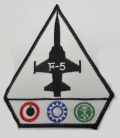
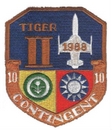
TRANSFER OR MODIFICATIONS
Known is the presence of four Northrop F-5A in USA, at Mojave airport. Some information state they were transformed to targers, others they were returned to Taiwan. Two were noted in the Republic of
the Philippine use, two are quoted to have gone to the same country.
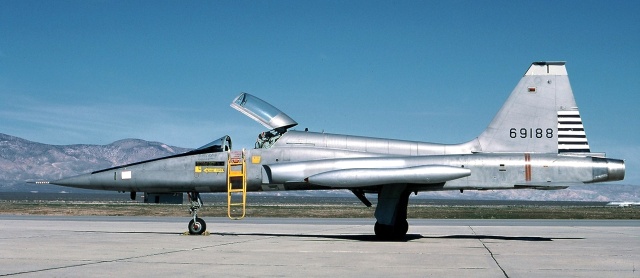
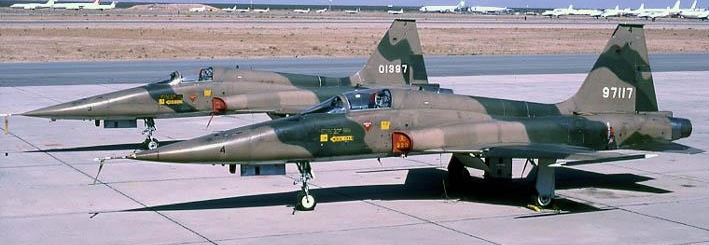
Northrop F-5A 69188 coded "1" at Mojave 13-02-88 Photo: D E Sloviak Northrop F-5A 97117 code "4" and 01397 code "3" at Mojave in 1988
UPGRADES
Taiwan's (Republic of China) Tiger upgrade program has a long history, starting in 1980 with a paper study; it included replacement of the General Electric J85 engines with one Garrett F125X engine, new Doppler
radar and upgrade the avionics and weapon systems, very similar to the Northrop F-20.
During the 1980s combat capacity of some Northrop F-5E and Northrop F-5F was improved with the addition of Litton ALR-46(V) radar warning receivers, Northrop AVQ-27 radar designators and Tracor ALE-401(V7)
chaff/flare dispenser; 500 AGM-65A Maverick TV guided air-to-surface missiles as well as Paveway II laser-guided bombs were also bought to improve the attack capability; aircraft aerodynamic was refined to some late
built aircrafts with the addition of the Tigershark nose. Modified aircrafts were designated F-5E module C and F-5F module F.
Air-to-air missiles AIM-9B Sidewinder were used by the Northrop F-5A, while the Northrop F-5E/F were mainly equipped with AIM-9P-4 Sidewinders.
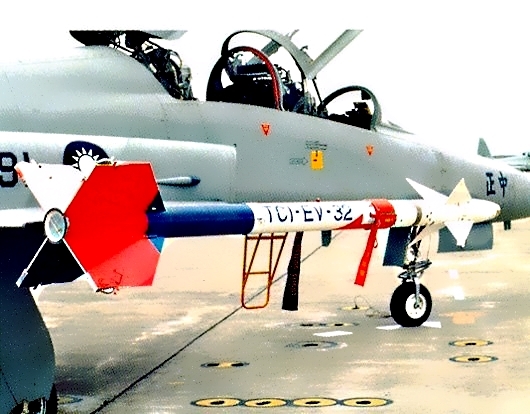
To diminish the dependance from USA a development programm forsimilar missiles was launched in the mid 80'. The military-run Chung
Shan Institute of Science and Technology (
the AIM-9 Sidewinder, called Tien Chen (Sky Word) TC-1 and an Beyond Visual Range missile, called Tien Chen (Sky Word) TC-2, but
both of them have not equipped the Northrop fighter, though the first test firing of the TC-1 was made by an F-5F in April 1986, with the
Beech target drone successfully destroyed. Photo: RoChina AF
Northrop F-5F 5391 30130 with Tien Chen (TC-1) evaluation missile. Photo: Republic of China Defence Ministry.
Structural and avionics/armament upgrades to keep the aircrafts operation were taken into consideration in 1990 and an initial request for information was sent to 10 companies, including Bristol Aerospace,
Grumman, Israel Aircraft industries, Singapore Aeroapace and Smiths Industries but all decisions were postponed and later cancelled, pending another request for Lockheed-Martin F-16s. Just limited structural
modification/upgrades were performed in the mid-90s to keep the aircrafts operational.
Foreseen retirement in May 1998 of the 12th Squadron Lockheed RF-104Gs reconnaissance aircrafts prompted requirement in 1995 for a new aircraft; the Air Force decided to modify 7 low-hours (number reduced
from the originally 10 planned) Northrop F-5E fighters into RF-5E reconnaissance aircrafts and favoured Singapore Aerospace for the modification, placing an order for the value of USD 50 million mentioning that
AIDC lacked sufficient experience. In the face of overwhelming criticism, however, the Air Force rescinded the deal with Singapore and permitted local AIDC company to participate in an open bidding, but finally
awarded the contract to Singapore Aerospace again. Aircrafts conversion started in 1996 and delivery of the first modified aircraft with KA-95 low altitude wide-angle, KA-97D front, RS-710E infrared cameras,
locally renamed Tigergazer, took place in August 1997.
Another attempt to upgrade the Northrop F-5E fighter failed in the mid-90s as collaboration with Northrop was unsuccesful; Westinghouse could not release, due to US export restrictions, the source code for the
foreseen AN/APG-66 radar (similar to the one used by the the Lockheed-Martin F-16), that would have enabled interface with the Sky Word TC-2 Beyond Visual Range missile. A model of the foreseen cockpit was
shown at the 1997 Taipei Aerospace Show.
In the late 1990's the local company Hanxiang Aviation Industry Co., Ltd proposed an improvement/upgrade (based on the avionics and weapon systems of the AIDC F-CK-1 'Jingguo/Ching-huo' local fighter) called
"Tiger 2000". The body and engines remained untouched while a new multi-functional Doppler radar (GD-53W Golden Dradon) was needed but not foreseen; otherwise performance was the same as the AIDC aircraft.
Many other improvements were also foreseen, including an updated mission computer, AN/ARN-153 tactical navigator, integrated control panel, improved radar warning, two multifunctional colour displays and
heads-up displays identical to the F-16A/B Block 20. A pylon on the fuselage could house the medium-range Tianjian 2 active-guided missile and make the aircraft a beyond-visual-range combat (BVR) fighter though
best performance of the new avionics was in the ground attack role, role short-legged due to the engine's insufficent thrust.
In the year 2000 AIDC borrowed a F-5E configuration C, serial 5308, as prototype. The prototype was first flown on 24-07-02 but the entire program was delayed by technical problems in replacing the plane's
complicated wiring systems and fixing the plane's engine,
The project was not pursuit as Northrop F-5Es due to lack of interest by the Air Force (which might have been interested in a less expensive upgrade of the radar only) and the purchase of next generation fighters,
the remaining aircrafts were relegated to training duties while the prototype was put on show at the Hsiang Yuan AIDC Park, seen first in May 2008.
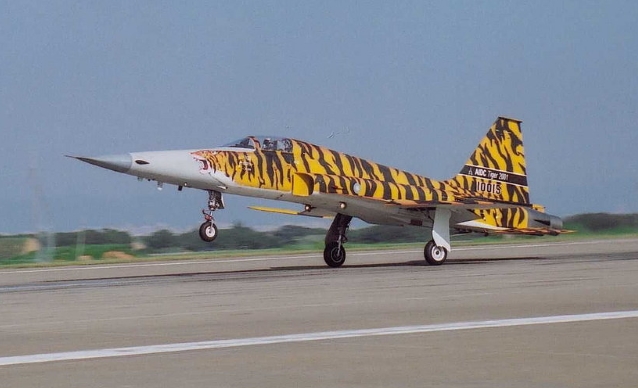
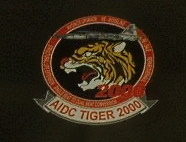 Programm AIDC Tiger 2000 badge
Programm AIDC Tiger 2000 badgeF-5E 2000 prototype serialled 10015 landing at Taichung in January 2004
RETIREMENT
People's Republic of China AF signature in 1991 of an initial contract for 20 Su-27SK single- and 4 Su-27UBK double-seaters, marked the beginning of the end of first line use of the Northrop F-5E. Next generation
fighters for the Republic of China AF were an absolute necessity to face these extremely powerful fighters.
Supply of the Lockheed-Martin F-16 was at last approved by President George Bush in 1992. The contract foresaw delivery of 120 F-16A Block 20 single- and 30 F-16B Block 20 two-seaters fighter/fighter-bombers
and trainers.
Additionally, a contract for 48 Dassault Mirage 2000-5Ei single- and 12 Dassault Mirage 2000-5Di double-seaters air-defence fighters/trainers was signed on 17-11-1992, deliveries starting in 1999.
The third new generation fighter component was in the form of the locally developed AIDC F-CK-1A/B Ching Kuo Indigenous Fighter. Development of this aircraft started when the US government refused to sell the
Northrop F-20 or Lockheed-Martin F-16. It was developed with help with US companies and resembles the F-16. A total of 250 were originally to be built, but only 102 AIDC F-CK-1A single- and 28 AIDC F-CK-1B
double-seaters were ordered following approval of the F-16 deal.
Deliveries of Lockheed-Martin F-16s started in April 1997 and the first, formerly F-5E equipped, 21st Squadron was commissioned in October 1997, last former F-5E Squadron being commissioned in the year 2002;
Dassault Mirage 2000-5s went to the 499th Tactical Fighter Wing, replacing Lockheed F-104G aircrafts, last arriving on November 26th, 1998; AIDC F-CK-1A/B Ching Kuo Indigenous Fighter re-equipped the
Northrop F-5E equipped 443rd (1st) Tactical Fighter Wing at Tainan beginning from 1997, the full Wing being officially commissioned on the new aircraft on 07-01-99.
At this point, there was no need anymore for Northrop F-5Es as fighter or fighter-bombers, though there were 166 in service in 2004 according to an official US source; they were gradually withdrawn from use and
offered to various countries. Mexico, Chile, the Philippines are thought to have been interested. But, due to political issues, there was no follow-up.
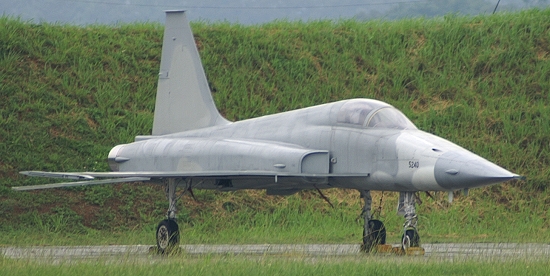
Unable to dispose the aircrafts to other countries, older ones were used as decoys, instruc tional airframes, preserved in
air bases, public parks as well as put at disposal of museums.
See serial list for full details.
The remaining active aircrafts are used for fighter lead-in training, or are in storage, forming a war reserve.
F-5E, possibly serial 5243, as decoy at Ching Chuang Kang AB in May 2006
Photo: Taiwan Air Blog
Photo: archive The Northrop F-5 Enthusiast
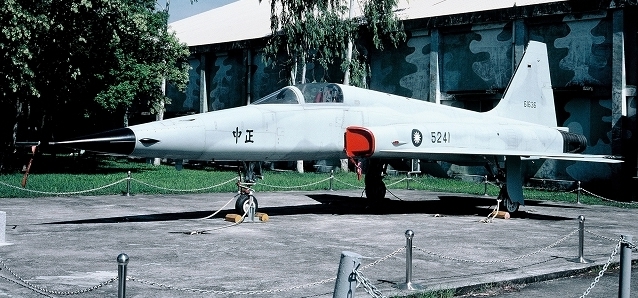
Northrop F-5E 5241 61636 preserved at Chiayi AB on 17-08-00
One Northrop F-5E and one F-5F, to be delivered beginning 2012, have been exchanged with one Douglas B-26 belonging to the Classic Aircrcraft Museum in USA.
Newer F-5Es and, mainly, F-5Fs (altogether approximately 60) were kept for advanced training of young pilots, before their operational conversion to the later generation General Dynamics F-16 and GAMD Mirage 2000s
at the respective Operational Conversion Units; older airframes were put at disposal for preservation, other active ones were put in storage, forming an emergency-reserve.
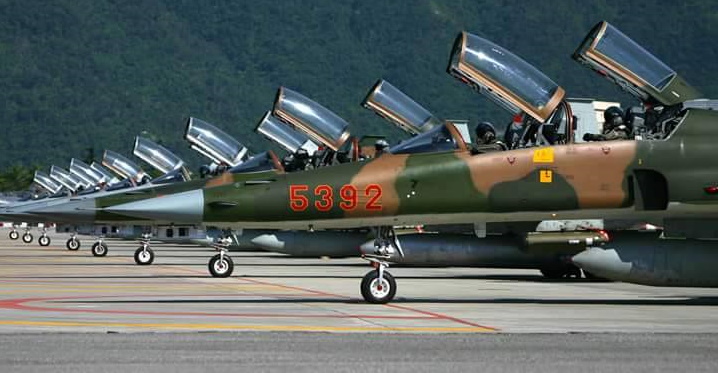 .
.Line-up of camouflaged and grey Northrop F-5F belonging to the 7th Wing
The remaining 6 Northrop RF-5Es (one has been lost) were not withdrawn but supplemented from 2004 by General Dynamics F-16As equipped with reconnaissance pods AN/AVDS-5.
Unfortunately reliability of the Northrop Tiger has diminished: seventeen single-/double-seaters have crashed between 1988 and 2007, killing 19 officers and leaving 4 pilots missing
There has been a high number of Northrop F-5F losses; in 32 years of active service as of July 2009, 40 have crashed killing 32 pilots, five accidents were between 2005 and 2009. Only 33 remained in service.
Final retirement of the remaining Northrop aircrafts has been foreseen for the year 2010, the advanced training role being taken-over by the AIDC F-CK-1A/B Ching Kuo Indigenous Fighter, in its turn replaced by new
General Dynamics F-16s. This target date has not been reached as the USA government has not approved the acquisition of the new fighter.
At present it is clamed to operate about 60 Tigers (of which 4 of the reconnaissance version) but an US government intelligence report mentions that only approximately 30 are possibly operationally capable. By March
2015 there were (apart from those listed in serial page) two Northrop F-5 used as decoys and one preserved at Hualien AB. Maintenance was taken care at Taitun/Zhihang AB, major overhaul at Pingtung AB.
The Indonesian AF Chief of Staff mentioned in March 2012 that they were considering the Republic of China offer for 1 Squadron of Northrop F-5E/Fs but finally he didn't accept it as they were quite different than the
ones already in use. Paraguay was another contry foreseen to receive (free of charge) Chinese Tiger in 1997 but the deal fell through as it was too expensive to operate the aircrafts.
An information given in May 2013 by the defence minister states that 32 aircrafts are in use, mainly for training, and they will be all retired by 2019. The USA requested sourcing of spare parts for the Tigers was given
on 01-11-18 , deadlined 16-11-18. Withdrawal of the type is foreseen by the year 2020.
Local press sources announced that General Electric J85 engines from retired Northrop F-5s are to be reverse-engineered, local produced to fit them to cruise missiles. An USA source stated that beginning 2019
20 Northrop F-5E, 31 Northrop F-5F and 5 Northrop RF-5E were in service plus 123 Northrop F-5E, 19 Northrop F-5F stored.
Taiwan rolled on 25-09-19 the prototype of the Advanced Jet Trainer AIDC T-5/AT-5 Yung-Ying (supersonic advanced jet trainer) to be ordered in 66 examples to replace ba 2026 Northrop F-5F and AIDC AT-3 trainers;
it gives a common platform for flight/tactical training and reduce operating costs. The trainer has interchangable parts with Indigenous Defense Fighter being developed locally. First production AIDC T-5 flew on
21-10-2021. It is foreseen that 7 Wing will receive the new trainer
A former Air Foce officer stated in October, 2020 that less than 50 Northrop were available.
All Tiger flights were suspended following a collisiion of 2 Northrop F-5Es on 22-10-21, suspension cancelled on 14-11-21, after completing major check-ups on the remaning Tigers and a test (on 13-11-22) flight by
the Commander-in-Chief of the Air Force with Northrop F-5F, serial 5261 at Taitung/Zhihang AB AFB.
It is foreseen the withradrawl from use of all Northrop F-5's by the end of 2023. Only one Northrop RF-5E will continue service for at least one year.